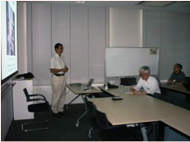イベント詳細
Seismic Tomography for Sumatra Great Earthquake Sequences and Characteristics of Surface Ground using Micro-tremor observations in Padang, Indonesia
開催日:2009年7月10日
場所:京都大学桂キャンパス Cクラスター C1 ゼミ室(117)
主催:
京都大学グローバルCOEプログラム「アジア・メガシティの人間安全保障工学拠点」
出席者数:約20名
Report
概要
The seminar of the Global COE program "Global Center for Education and Research on Human Security Engineering for Asian Megacities" was held at Seminar 2 (room 117) on July 10th, 2009. The purpose of the seminar is to disseminate recent research programs in the fields of micro-tremor earthquakes, tomographic imaging, InSAR analysis for Yogyakarta's earthquake and advanced seismic data processing.
報告
Prof. Sri Widiyantoro talked about his recent research that was seismic tomography and great earthquake sequences in Sumatera. Basically his topics were divided into two groups that were seismicity in the Indonesian region and seismic tomographic imaging of Sumatra. He then explained about Indonesian region that is tectonically so active and volcanism related to subduction processes.
Takeshi Tsuji talked about his research topics of earthquake fault of 2006 Yogyakarta earthquake using inSAR analysis. He explained the result about surface deformation due to the earthquake. Then the speaker concluded that deformation map can be estimated by using InSAR in which surface deformation occurred ~10 km east of the Opak River fault. In addition, location of inferred seismogenic fault is consistent with aftershock epicenters.
Rachmat Sule explained his recent research about Common Reflection Surface (CRS) stack and its applications in the several oil fields in Indonesia. In general, the speaker concluded that Zero Offset (ZO) CRS-Stack method gives better image of subsurface condition, especially in low-fold seismic data. He also mentioned about research collaboration that is conducting between ITB and Pertamina to build CRS commercial software.
The last speaker was Prof. Junji KIYONO talked about dynamic characteristics of surface ground by using micro-tremor observations in Padang. His activities include installing seismometers in several places to record earthquake data, micro-tremor observations and dynamic seismic analysis. In addition to the topic, he also mentioned about activities of his students to give education for people in Padang and Yogyakarta to save their lives when an earthquake happens.
More than 20 participants attended the symposium, bringing together not only professors, but also a large number of students, reflecting a growing interest in the earthquake seminar.


